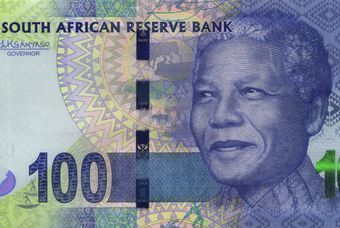The Shutdown That Turned the Rand into a Global Barometer
As the U.S. shutdown drags on, USD/ZAR (ZAR=) slides toward 18.9, USD/NGN (NGN=) nears 1,620, and USD/KES (KES=) hits 129.4. Dollar strength (DXY: DX-Y.NYB ≈ 105.8) and high US10Y (CBOE: ^TNX ≈ 4.35%) expose how Washington’s gridlock ripples through Africa’s markets.

Global markets have grown restless as Washington’s fiscal paralysis stretches into its third week, freezing key economic data and disrupting Treasury operations. The U.S. government shutdown—now extending beyond its second week—is no longer just an American story. Its tremors are spreading across continents, testing the resilience of frontier economies whose policy buffers are already stretched thin.
The South African rand (USD/ZAR: ZAR=) was the first African currency to flinch, weakening toward 18.90 per dollar, its lowest level in a month. Investors are recalibrating what an extended halt to U.S. data releases, spending, and Treasury issuance could mean for global liquidity. The irony is that South Africa’s fundamentals remain steady: inflation is contained at 4.8 percent, the SARB repo rate sits at 8.25 percent, and the 10-year ZAR2035 yield anchors near 10.4 percent, among the world’s highest real returns. Yet the rand still suffers—not because the domestic economy faltered, but because global signals vanished.
A U.S. shutdown distorts more than paychecks—it scrambles the feedback loop of monetary policy. With key releases like nonfarm payrolls, CPI, and Treasury auction data delayed, investors lose the compass that guides Federal Reserve expectations. In that vacuum, cash and short-term Treasuries become the only refuge, lifting the U.S. Dollar Index (DXY: DX-Y.NYB) above 105 and tightening liquidity worldwide. Carry trades unwind, volatility spikes, and emerging-market currencies—funded by dollar inflows—snap back violently.
This vulnerability stretches across the continent. The Nigerian naira (USD/NGN: NGN=) and Kenyan shilling (USD/KES: KES=) have each depreciated 1–1.5 percent since the standoff began as offshore investors retreat into dollar assets. Both nations rely heavily on external financing—Nigeria through Eurobond markets, Kenya via syndicated loans and diaspora inflows. A prolonged U.S. impasse constrains these flows, delaying budget execution and widening current-account gaps. Even modest Treasury disruptions in Washington translate into higher funding costs in Nairobi and Lagos.
Bond traders are already pricing stress. South Africa’s R2032 Eurobond (ISIN XS2051363054) widened by 25 basis points in early October, mirroring losses in Ghana and Egypt. Such moves can snowball when ETFs like the iShares JPMorgan EM Bond ETF (NYSEARCA: EMB) rebalance away from high-beta frontier markets. The resulting feedback loop is familiar: weaker currencies lift inflation expectations, forcing central banks to stay hawkish, which then constrains growth—a cycle imported from abroad.
The rand’s role as Africa’s bellwether magnifies this effect. Traders often treat it as a proxy for frontier-market risk, so when the rand slides, regional currencies follow suit regardless of fundamentals. Botswana’s pula, Zambia’s kwacha, and Namibia’s dollar—all either pegged or highly correlated—tend to mirror its direction. The U.S. shutdown, therefore, becomes a pan-African confidence test disguised as a political standoff 13,000 kilometers away.
Ironically, the same dollar strength punishing African currencies is lifting commodities. Investors seeking hedges are rotating into gold (XAU/USD) and Brent crude (ICE: LCOc1), both near multi-month highs. South Africa’s mining exports—gold, platinum, coal—stand to benefit, temporarily cushioning trade balances even as portfolio flows reverse. For oil importers like Kenya, Rwanda, and Tanzania, the opposite holds true: higher import bills amplify inflation and squeeze fiscal headroom. Each USD 5 rise in Brent adds about 0.3 percentage points to Kenya’s inflation and widens Tanzania’s current-account deficit by roughly USD 250 million per quarter.
This divergence will shape Africa’s macro trajectory in the coming months. Commodity exporters may enjoy temporary relief, while import-dependent economies endure compounded shocks. “Global contagion” today travels not through trade but through algorithms, cross-asset correlations, and risk premiums—mechanisms that move faster than policy can respond.
Meanwhile, the broader macro distortions continue. Treasury supply bottlenecks are pushing short-term yields higher; the U.S. 10-year yield (US10Y: ^TNX) hovers near 4.35 percent, while risk spreads on African Eurobonds widen in tandem. Investors who once saw African debt as a yield play are now rotating out—not because of domestic weakness, but because Washington’s dysfunction has made global risk more expensive to hold.
The pattern isn’t unique to Africa. The Mexican peso (USD/MXN: MXN=) and Indonesian rupiah (USD/IDR: IDR=) have both weakened amid similar unwinding of carry trades, underscoring how fiscal gridlock in the U.S. can ripple across every emerging region. The VIX Index (CBOE: VIX) has climbed to its highest level since February, and even Bitcoin (BTC-USD) and gold are moving in tandem—a signal that investors are searching for alternatives to policy-driven assets.
For policymakers in open African economies, perception now matters as much as fundamentals. The rand’s decline has become shorthand for frontier risk; its fluctuations dictate how global funds price the region. The challenge is managing expectations in a world where domestic prudence cannot offset imported volatility. Even countries with credible central banks and fiscal reforms remain vulnerable when dollar liquidity tightens and investor psychology turns defensive.
In the end, what begins as a budget impasse in Washington can echo across African capitals, forcing rate hikes, delayed debt issuance, and renewed foreign-exchange intervention. The rand’s weakness is not a verdict on South Africa’s policy discipline—it’s a symptom of how deeply African markets are wired into global liquidity cycles.
When Washington stalls, the world flinches. Political paralysis in the world’s largest economy now transmits through screens faster than through policy. The next time the rand slips, it may not be reacting to Johannesburg’s data at all—but to another fiscal standoff on Capitol Hill that Africa can neither influence nor avoid.





